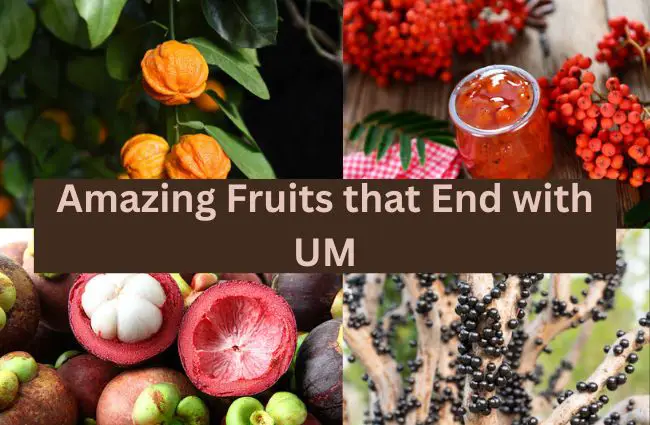Helpful Guides on each Category

Want to know popular plants that start with the letter c, well this blog post has listed more than 40 of such plants. I’ve also included bonuses on plants that start with c from various countries.
Let’s get into this real quickly;
Trees that Start with C
1. California Redwood (Sequoia sempervirens):
The tallest tree species on Earth, reaching up to 379 feet tall, with reddish-brown, fibrous bark and drooping branches. Slow-growing, fire-resistant, and incredibly long-lived (up to 3,000 years). National symbol of California.

- Scientific Name: Sequoia sempervirens
- Colour: Deep green needles, turning rusty red in fall.
- Nativity: Coastal California and Oregon.
- Flowering: Yes, small, cone-like structures.
- Edible Parts: None.
- Flowering Season: Spring.
Read Also: Squash or Weed: 26 Weeds That Look Like Squash Plant (Pictures)
2. Cedar (Cedrus spp.):
Aromatic evergreen trees with wide-spreading branches and scaly bark. Varieties include Atlas Cedar, Deodar Cedar, and Eastern Red Cedar. Used for lumber, essential oils, and landscaping. Some varieties have fragrant wood.
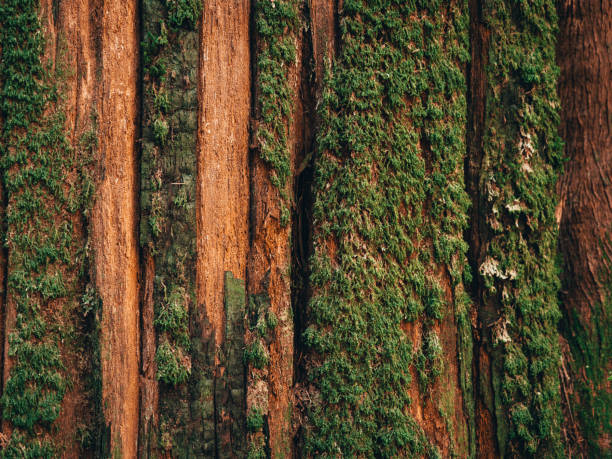
- Scientific Name: Cedrus spp. (Different species have different names)
- Color: Deep green to blue-green needles.
- Nativity: Himalayas, Mediterranean, and North America.
- Flowering: Yes, small, cone-like structures.
- Edible Parts: None.
- Flowering Season: Spring.
3. Cherry (Prunus spp.):
Deciduous trees with smooth, grey bark and drooping branches. Varieties include sweet cherry, sour cherry, and ornamental cherry. Prized for their beautiful flowers and edible fruits. Some varieties are poisonous.
- Scientific Name: Prunus spp. (Different species have different names)
- Color: Green leaves with white, pink, or red flowers.
- Nativity: Europe, Asia, and North America.
- Flowering: Spring, with showy blossoms.
- Edible Parts: Fruits (cherries) in some varieties.
- Flowering Season: Spring.
4. Chestnut (Castanea spp.):
Deciduous trees with thick, deeply grooved bark and large, glossy leaves. Varieties include American chestnut and European chestnut. Formerly a dominant tree in North American forests, devastated by chestnut blight. They are Prized for their edible nuts and valuable wood.
- Scientific Name: Castanea spp. (Different species have different names)
- Color: Green leaves with creamy white flowers.
- Nativity: North America, Europe, and Asia.
- Flowering: Early summer, with inconspicuous flowers.
- Edible Parts: Nuts (chestnuts) in some varieties.
- Flowering Season: Early summer.
5. Cypress (Cupressus spp.):
Tall, slender evergreen trees with conical crowns and dense foliage. Varieties include Italian cypress and Arizona cypress. Popular for landscaping due to their compact form and evergreen nature. Used in cemeteries and gardens.
- Scientific Name: Cupressus spp. (Different species have different names)
- Color: Deep green to blue-green foliage.
- Nativity: Eurasia and North America.
- Flowering: Yes, small, cone-like structures.
- Edible Parts: None.
- Flowering Season: Spring.
Shrubs and vines that start with C
1. Camellia (Camellia spp.):
Evergreen shrubs or small trees with glossy, dark green leaves and showy flowers in shades of white, pink, red, and purple. Popular varieties include japonica, sasanqua, and reticulata. Known for their beautiful and long-lasting flowers, camellias are popular ornamental shrubs. Some varieties are cold-hardy, while others prefer warmer climates.
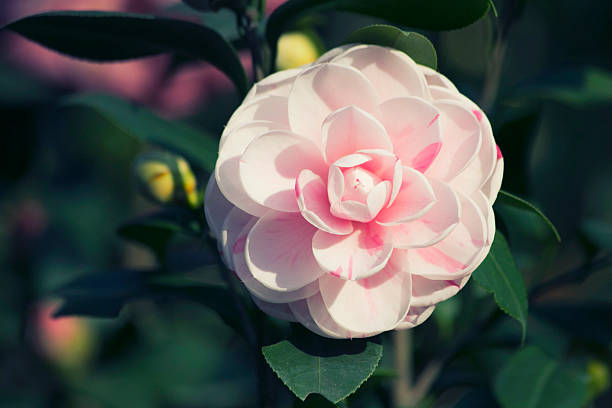
- Scientific Name: Camellia spp. (Different species have different names)
- Colour: Deep green leaves with vibrant blooms in various colours.
- Nativity: East Asia and Southeast Asia.
- Flowering: Fall, winter, or spring depending on the variety.
- Edible Parts: No, the seeds are poisonous.
- Flowering Season: Varies by species, but generally fall, winter, or spring.
2. Clematis (Clematis spp.):
Deciduous or evergreen vines with climbing stems and star-shaped or bell-shaped flowers in a wide range of colours, including blue, purple, pink, white, and yellow. Clematis are versatile climbers that can be trained to grow over trellises, fences, or arches. They require well-drained soil and moderate sunlight.
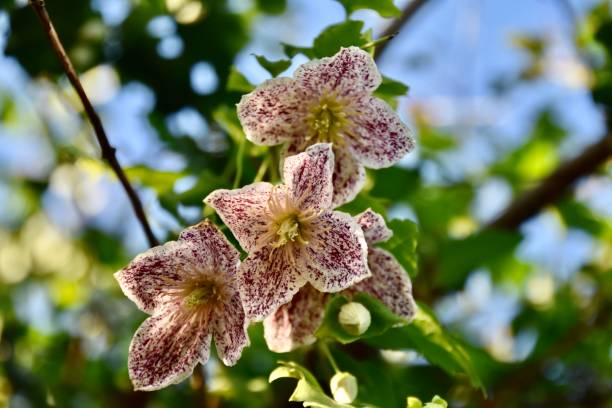
- Scientific Name: Clematis spp. (Different species have different names)
- Colour: Green leaves with diverse and vibrant flower colours.
- Nativity: Europe, Asia, and North America.
- Flowering: Spring, summer, or fall depending on the variety.
- Edible Parts: No, all parts of the plant are poisonous.
- Flowering Season: Varies by species, but generally spring, summer, or fall.
3. Columbine (Aquilegia spp.):
Perennial plants with fern-like foliage and delicate, long-spurred flowers in shades of purple, blue, pink, white, and yellow. Columbines are attractive and easy-to-care-for perennials that thrive in cool climates and partial shade. They attract hummingbirds and other pollinators.
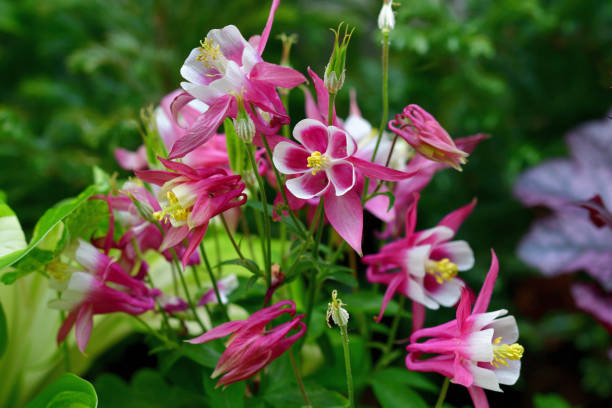
- Scientific Name: Aquilegia spp. (Different species have different names)
- Colour: Green, feathery foliage with dainty flowers in various hues.
- Nativity: Northern Hemisphere, including Europe, Asia, and North America.
- Flowering: Late spring to early summer.
- Edible Parts: No, the leaves and seeds are poisonous.
- Flowering Season: Late spring to early summer.
4. Coral Bells (Heuchera spp.):
Low-growing perennials with rounded leaves in various shades of green, purple, and red. Some varieties have variegated foliage. They produce small, bell-shaped flowers in shades of white, pink, and red. Coral bells are versatile perennials that tolerate various soil conditions and light levels. They are prized for their attractive foliage and long-lasting blooms.
- Scientific Name: Heuchera spp. (Different species have different names)
- Colour: Diverse foliage colours like green, purple, and red, with delicate bell-shaped flowers.
- Nativity: North America.
- Flowering: Early summer to midsummer.
- Edible Parts: No, the leaves and roots are poisonous.
- Flowering Season: Early summer to midsummer.
5. Cotoneaster (Cotoneaster spp.):
Evergreen or deciduous shrubs with small, rounded leaves and clusters of white or pink flowers in spring. Some varieties produce red berries in the fall. Cotoneasters are popular landscaping shrubs that are relatively low-maintenance. They provide year-round interest with their attractive foliage, flowers, and berries.
- Scientific Name: Cotoneaster spp. (Different species have different names)
- Colour: Evergreen or deciduous foliage with white or pink blossoms, followed by red berries in some varieties.
- Nativity: Europe, Asia, and the Himalayas.
- Flowering: Spring.
- Edible Parts: The berries of some varieties are edible, but should be consumed with caution as they can cause stomach upset if eaten in large quantities.
- Flowering Season: Spring.
6. Clover (Trifolium spp.):
Low-growing plants with three-lobed leaves in various shades of green. Some varieties have white, pink, or red flowers. Clover is a nitrogen-fixing legume that improves soil fertility. It is also a symbol of good luck and fortune in many cultures.
- Scientific Name: Trifolium spp. (Different species have different names)
- Colour: Green leaves, with some varieties boasting white, pink, or red flowers.
- Nativity: Europe, Asia, and Africa.
- Flowering: Spring or summer depending on the variety.
- Edible Parts: Yes, the leaves and flowers are edible and can be eaten raw, cooked, or dried.
- Flowering Season: Spring or summer depending on the variety.
7. Coleus (Solenostemon scutellarioides):
Vibrant foliage plants with colourful, scalloped leaves in shades of green, purple, pink, red, and orange. Some varieties have variegated leaves. Insignificant flowers may appear in late summer or fall, but the plant is valued for its foliage all season long. Coleus is a popular foliage plant for both outdoor and indoor gardens. It thrives in warm weather and partial shade.
- Scientific Name: Solenostemon scutellarioides
- Colour: Dazzling foliage in a stunning array of colours like green, purple, pink, red, and orange, with some varieties exhibiting variegation.
- Nativity: Southeast Asia and India.
- Flowering: Insignificant blue flowers, but grown primarily for their foliage.
- Edible Parts: No, all parts of the plant are mildly toxic and can cause stomach upset if ingested.
Flowers that Start with C:
1. Calla Lily (Zantedeschia aethiopica):
This elegant beauty features trumpet-shaped blooms in classic white or vibrant shades like yellow, orange, and pink. A distinctive spadix adds intrigue to the centre. Symbolizes purity, elegance, and new beginnings.
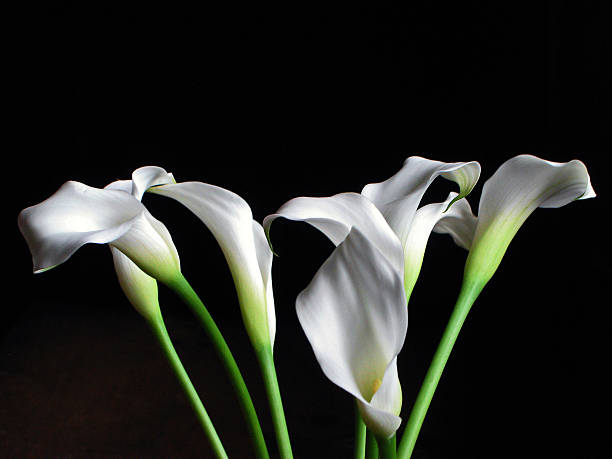
- Scientific Name: Zantedeschia aethiopica
- Colour: Flowers in white, yellow, orange, and pink; leaves are glossy green.
- Nativity: South Africa.
- Flowering: Yes, late spring to early summer.
- Edible Parts: No, all parts are poisonous.
- Flowering Season: Late spring to early summer.
2. Carnation (Dianthus caryophyllus):
Loved for their sweet fragrance and ruffled petals, carnations come in a dazzling array of colours like red, pink, white, yellow, purple, and even green. Represent love, admiration, and gratitude. A popular choice for bouquets and celebrations.
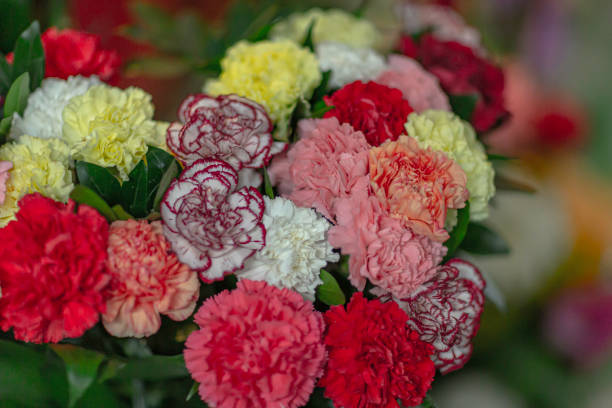
- Scientific Name: Dianthus caryophyllus
- Colour: Flowers in a wide range of colours; leaves are grey-green.
- Nativity: Mediterranean region.
- Flowering: Yes, throughout the year with proper care.
- Edible Parts: No, all parts are mildly toxic.
- Flowering Season: Year-round with proper care.
3. Cosmos (Cosmos bipinnatus):
These cheerful annuals are easy to grow and boast vibrant daisy-like flowers in shades of pink, purple, white, red, orange, and yellow. They attract pollinators like butterflies and bees. Add a touch of whimsy to gardens and borders.
- Scientific Name: Cosmos bipinnatus
- Colour: Flowers in various shades of pink, purple, white, red, orange, and yellow; leaves are feathery green.
- Nativity: Mexico.
- Flowering: Yes, summer and early fall.
- Edible Parts: No, all parts are mildly toxic.
- Flowering Season: Summer and early fall.
4. Crocus (Crocus spp.):
Harbingers of spring, these delicate cup-shaped flowers in purple, yellow, white, and blue emerge early, signalling the arrival of warmer days.
- Scientific Name: Crocus spp. (Several species exist)
- Color: Flowers in purple, yellow, white, and blue; leaves are green and grass-like.
- Nativity: Europe, Asia, and the Middle East.
- Flowering: Yes, early spring.
- Edible Parts: No, the corms are mildly toxic and should not be consumed.
- Flowering Season: Early spring.
5. Cyclamen (Cyclamen persicum):
These winter-blooming houseplants brighten up the cold months with their delicate, butterfly-like flowers in pink, white, red, and purple. They emit a delightful fragrance.
- Scientific Name: Cyclamen persicum
- Colour: Flowers in pink, white, red, and purple; leaves are heart-shaped and green with silver marbling.
- Nativity: Eastern Mediterranean.
- Flowering: Yes, winter and early spring.
- Edible Parts: No, all parts are poisonous.
- Flowering Season: Winter and early spring.
Grasses that start with C
1. Crested Dogtail Grass (Pennisetum alopecuroides):
This ornamental grass features fountain-like clumps of feathery green blades with fluffy, bottlebrush-like seedheads in late summer. Low-maintenance, drought-tolerant, and perfect for adding texture to gardens.
- Colour: Green blades with buff-coloured seedheads.
- Nativity: Africa and Eurasia.
- Edible Parts: No, not typically consumed.
2. Calamagrostis (Calamagrostis spp.):
This genus of ornamental grasses encompasses various species with differing heights and forms, offering options for borders, meadows, and containers. Common types include reed grass and feather reed grass.
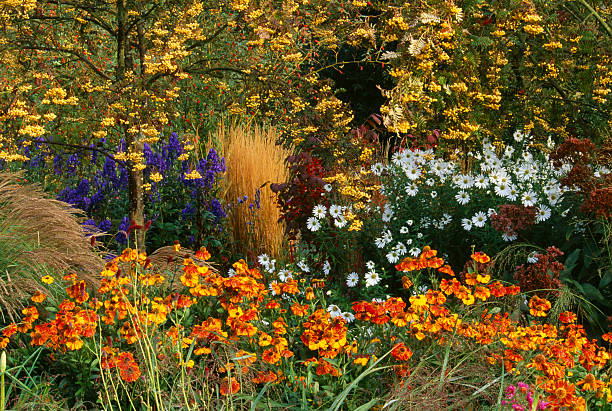
- Color: Green, blue-green, or even golden depending on the species.
- Nativity: Various regions in Europe, Asia, and North America.
- Edible Parts: No, not typically consumed.
- Other Information: Provide wind movement and visual interest in gardens.
Ferns that start with C:
1. Cinnamon Fern (Osmundastrum Cinnamomum)
This majestic fern boasts tall, reddish-brown fiddleheads in spring that unfurl into large, graceful fronds, adding a touch of prehistoric charm to gardens. Prefers moist, shady locations and thrives near ponds or water features.
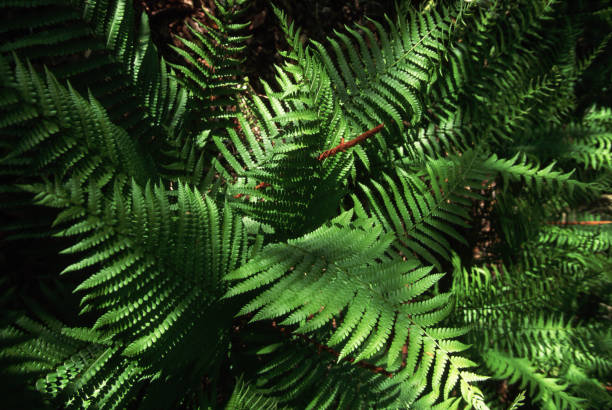
- Color: Green fronds with reddish-brown fiddleheads.
- Nativity: Eastern North America and Asia.
- Edible Parts: No, the fronds are toxic.
2. Copper Fern (Dryopteris erythrosora):
This delicate fern showcases feathery, arching fronds in shades of green and copper, bringing a touch of elegance to shady areas.
- Color: Green fronds with hints of copper or bronze.
- Nativity: Widespread in temperate regions of the Northern Hemisphere.
- Edible Parts: No, the fronds are toxic.
Vegetables and Herbaceous Plants that Start with C:
1. Cabbage (Brassica oleracea var. capitata):
A leafy vegetable with tightly packed, thick leaves forming a head in various shapes and colours, including green, red, purple, and white. Popular varieties include green cabbage, red cabbage, Savoy cabbage, and Napa cabbage. Good source of vitamins C and K, dietary fibre, and antioxidants. Versatile ingredients in salads, stir-fries, soups, and stews.
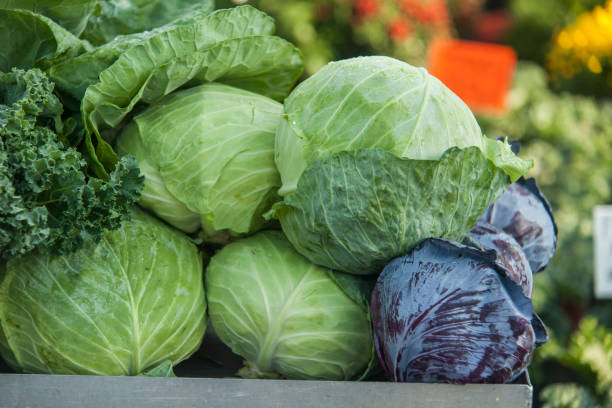
- Scientific Name: Brassica oleracea var. capitata
- Colour: Green, red, purple, or white leaves.
- Nativity: Europe and Asia.
- Edible Parts: All parts, including leaves, stems, and core.
- Season: Depending on the variety, available in summer, fall, or winter.
2. Carrots (Daucus carota subsp. sativus):
Crunchy taproots are most commonly known in their orange form but are also available in purple, yellow, and white varieties. They have a sweet, earthy flavour and a slender, cylindrical shape. Rich in vitamin A and beta-carotene, promoting healthy vision. Can be eaten raw, cooked, or juiced.

- Scientific Name: Daucus carota subsp. sativus
- Color: Orange, purple, yellow, or white roots; green feathery leaves.
- Nativity: Europe and Asia.
- Edible Parts: The taproot.
- Season: Spring and summer, but can be stored for winter consumption.
3. Cauliflower (Brassica oleracea var. botrytis):
A member of the cabbage family, forming a white, tightly packed head of tightly bunched florets. Popular varieties include white cauliflower, Romanesco cauliflower, and purple cauliflower. Good source of vitamins C and K, dietary fibre, and antioxidants. Versatile ingredient in soups, roasts, and even as a rice substitute.
- Scientific Name: Brassica oleracea var. botrytis
- Colour: White, green (Romanesco), or purple florets; green leaves.
- Nativity: Europe and Asia.
- Edible Parts: The florets and leaves.
- Season: Autumn.
4. Celery (Apium graveolens var. dulce):
Crisp, green stalks with hollow centres and feathery leaves. The base forms a bulb-like structure called the celeriac. Low in calories and a good source of vitamins A, C, and K, and potassium. Popular ingredients in salads, soups, and juices.
- Scientific Name: Apium graveolens var. dulce
- Colour: Green stalks and leaves.
- Nativity: Europe and Asia.
- Edible Parts: Stalks, leaves, and celeriac.
- Season: Late summer and fall.
5. Chard (Beta vulgaris subsp. cicla):
Leafy green with large, crinkled leaves and colourful stalks in shades of white, green, red, yellow, and pink. The chard stalks are thick and fleshy, similar to celery. Rich in vitamins A, C, and K, and dietary fiber. Versatile ingredient in stir-fries, salads, and as a wrapper for dolmas.
- Scientific Name: Beta vulgaris subsp. cicla
- Colour: Green leaves with colourful stalks (white, green, red, yellow, pink).
- Nativity: Mediterranean region.
- Edible Parts: Leaves and stalks.
- Season: Spring and summer, also possible in fall with mild weather.
6. Chives (Allium schoenoprasum):
Delicate, grass-like perennial herb with hollow, tubular leaves up to 20 inches long. Forms dense clumps of thin bulbs. Mild onion flavour. Easy to grow in pots or gardens. Adds a subtle oniony flavour to dishes like eggs, soups, dips, and salads.
- Scientific Name: Allium schoenoprasum
- Color: Deep green leaves with purple, spherical flower heads blooming in late spring to early summer.
- Nativity: Europe, Asia, and North America.
- Edible Parts: Leaves and flowers.
- Season: Year-round in mild climates, spring to fall in colder regions.
7. Cilantro (Coriandrum sativum):
Erect annual herb with bright green, lacy leaves and small, white flowers in clusters. Distinctive citrusy and peppery flavour.
Commonly used in Mexican, Asian, and Latin American cuisine. Leaves tend to bolt (develop flowers) in hot weather. Seeds are used as a spice called coriander.
- Scientific Name: Coriandrum sativum
- Color: Deep green, feathery leaves with white flower clusters.
- Nativity: Mediterranean region.
- Edible Parts: Leaves and seeds (coriander).
- Season: Late spring to early summer.
8. Corn (Zea mays):
Tall, annual grass with large, broad leaves and tassel-like flowers at the top. Produces starchy kernels on cobs enclosed by husks.
Staple food crops worldwide. Sweet corn varieties enjoyed fresh, roasted, or canned. Kernels can be ground into cornmeal and flour.
- Scientific Name: Zea mays
- Colour: Green stalks and leaves, yellow kernels.
- Nativity: Central America.
- Edible Parts: Kernels (sweet corn) and cob (baby corn).
- Season: Summer.
9. Cucumbers (Cucumis sativus):
Climbing or vining annual with elongated, green fruits with crisp, watery flesh and mild flavour. Various shapes and sizes exist.
Versatile ingredients in salads, sandwiches, dips, and pickles. Rich in vitamins and minerals.
- Scientific Name: Cucumis sativus
- Color: Green fruits with darker green stripes in some varieties.
- Nativity: India.
- Edible Parts: Fruits (cucumber).
- Season: Summer.
10. Chamomile:
There are two main types of chamomile commonly used:
Roman Chamomile (Chamaemelum nobile):
Low-growing perennial herb with feathery green leaves and daisy-like flowers with yellow centers and white petals. Sweet, apple-like fragrance. Popularly used in herbal teas, known for its calming and digestive properties.
- Scientific Name: Chamaemelum nobile
- Color: Green leaves with white and yellow daisy-like flowers.
- Nativity: Europe and Asia.
- Edible Parts: Flowers and leaves.
- Season: Summer.
German Chamomile (Matricaria recutita):
Similar to Roman chamomile, but with smaller flowers and a stronger, apple-like scent. Commonly used in herbal teas and extracts for similar calming and digestive benefits as Roman chamomile.
- Scientific Name: Matricaria recutita
- Color: Green leaves with small white and yellow daisy-like flowers.
- Nativity: Europe and Asia.
- Edible Parts: Flowers and leaves.
- Season: Summer.
11. Chervil:
Delicate annual herb with lacy, fern-like leaves and small, white flower clusters. Mild anise-like flavor. Adds a subtle liquorice-like flavour to salads, soups, and sauces. Difficult to
- Scientific Name: Anthriscus cerefolium
- Colour: Light green, feathery leaves with white flower clusters.
- Nativity: Mediterranean region.
- Edible Parts: Leaves and flowers.
- Season: Spring and early summer.
12. Cornflower:
Cornflowers are beautiful annual or perennial wildflowers with daisy-like flowers in vibrant shades of blue, purple, and pink. They have tall, slender stems with narrow, green leaves. Cornflowers are popular additions to gardens and meadows, attracting pollinators like bees and butterflies.
Cornflowers symbolize hope, faith, and remembrance. They are drought-tolerant and easy to grow in full sun. Cornflowers can be used as cut flowers or dried for arrangements. The petals are edible and can be used to decorate cakes or salads.
- Scientific Name: Centaurea cyanus
- Color: Blue, purple, pink, or white flowers with green leaves.
- Nativity: Europe and Asia.
- Edible Parts: Petals (though not commonly consumed).
- Season: Summer and early fall.
Delicious Fruits Starting with Letter C:
1. Cantaloupe (Cucumis melo subsp. cantalupensis):
Sweet and refreshing melon with orange-pink flesh and netted rind. Available in various shapes and sizes. Popularly enjoyed fresh, but can also be added to salads, smoothies, and desserts.
- Scientific Name: Cucumis melo subsp. cantalupensis
- Colour: Orange-pink flesh, green or yellow rind with netting.
- Nativity: Africa and Asia.
- Season: Summer and early fall.
- Nutritional Value: Rich in vitamins A and C, potassium, and dietary fiber.
2. Cherries (Prunus avium and P. cerasus):
Small, round fruits with juicy flesh and a single pit. Popular varieties include sweet cherries (P. avium) and tart cherries (P. cerasus). Available in red, black, and yellow varieties. Enjoyed fresh, used in baking, jams, and juices. Tart cherries are known for their sour flavour and potential health benefits.
- Scientific Name: Prunus avium (sweet cherries) and Prunus cerasus (tart cherries)
- Color: Red, black, or yellow fruit.
- Nativity: Europe and Asia.
- Season: Sweet cherries ripen in early summer, tart cherries in late summer.
- Nutritional Value: Excellent source of vitamin C, antioxidants, and potassium.
3. Coconut (Cocos nucifera):
Large, drupe fruit with a hard outer shell enclosing a white flesh and sweet-tasting liquid (coconut water). Versatile fruit used in culinary, cosmetic, and industrial applications. Coconut flesh is enjoyed fresh, dried, or as coconut milk.
- Scientific Name: Cocos nucifera
- Colour: Brown hairy outer shell, white flesh.
- Nativity: Tropical regions of the Pacific, Indian, and Atlantic Oceans.
- Season: Year-round, peak season varies by region.
- Nutritional Value: Rich in fiber, medium-chain triglycerides (MCTs), and minerals.
4. Cranberries (Vaccinium macrocarpon):
Tart, small, red berries that grow in bogs. Often consumed dried or juiced due to their sourness. Commonly associated with Thanksgiving and holiday dishes. Used in juices, sauces, jams, and desserts. Cranberries are known for their potential health benefits in preventing urinary tract infections (UTIs).
- Scientific Name: Vaccinium macrocarpon
- Colour: Deep red berries.
- Nativity: North America.
- Season: Fall and early winter.
- Nutritional Value: Rich in vitamins A and C, fibre, and antioxidants.
5. Currants (Ribes spp.):
Small, juicy berries grow in clusters on shrubs. Available in various colours and flavours, including red, black, and white currants. Some varieties are sweet, while others are tart. Used in jams, pies, desserts, and juices. Some varieties can be eaten fresh. Black currants are known for their high vitamin C content.
- Scientific Name: Ribes spp. (Several species exist)
- Colour: Red, black, or white berries.
- Nativity: Europe and Asia.
- Season: Summer.
- Nutritional Value: Good source of vitamins C and K, antioxidants, and fibre.
Houseplants that start with C:
1. Cactus (Cactaceae spp.):
These spiky wonders come in a vast array of shapes and sizes, from the iconic saguaro to the charming bunny ear cactus. They offer unique textures and low maintenance needs.
- Species: Opuntia, Mammillaria, Echinocactus, Ferocactus, and many more.
- Needs: Bright light, well-draining soil, infrequent watering.
2. Calathea (Calathea spp.):
Calatheas are known for their stunning foliage, with vibrant patterns and jewel tones like emerald green, burgundy, and silver. Their leaves often move in response to light, adding a dynamic touch.
- Species: Calathea orbifolia, C. zebrina, C. makoyana, C. roseopicta, and many more.
- Needs: Moderate to bright indirect light, slightly moist soil, moderate humidity.
3. Chinese Money Plant (Pilea peperomioides):
This adorable succulent boasts round, coin-shaped leaves on plump, reddish stems. It’s easy to care for and propagates readily, making it a popular choice for beginners. The Chinese Money Plant is said to bring good luck and prosperity to its owner.
- Species: Pilea peperomioides.
- Needs: Bright to moderate indirect light, well-draining soil, infrequent watering.
4. Crown of Thorns (Euphorbia milii):
This spiny shrub features clusters of bright red or yellow flowers atop its thorny branches. Its unique appearance and vibrant blooms make it a statement piece for any home. The Crown of Thorns is relatively pest- and disease-resistant.
- Species: Euphorbia milii.
- Needs: Bright light, well-draining soil, infrequent watering.
5. Cyclamen (Cyclamen persicum):
These delicate beauties boast heart-shaped leaves and delicate, upward-facing flowers in shades of pink, white, purple, and red. They add a touch of elegance and charm to any space. Cyclamens bloom for several months with proper care.
- Species: Cyclamen persicum.
- Needs: Cool temperatures, bright indirect light, moist but not soggy soil.
6. Caladium (Caladium bicolor):
This stunner features arrow-shaped leaves with vibrant variegation in shades of green, white, pink, and purple. They add a tropical touch to any room, requiring moderate to bright indirect light and well-draining soil.
What is the purple flower with the name C?
The following are flowering plants that start with c which have purple flowers;
Clematis
These captivating climbers drape gardens in cascades of purple stars, adding vibrant charm to fences and trellises.
Crocus
Spring’s cheerful harbingers, and crocuses carpet grassy patches with bursts of amethyst and lavender, ushering in the warmer months.
Columbine
Dainty and delicate, columbines boast intricate flowers in shades of deepest violet, resembling ruffled skirts dancing in the breeze.
Catnip
Not just for felines, catnip offers a delightful surprise with its soft spikes of lavender blooms, attracting a host of pollinators to your garden.
Cardinal Flower
A vibrant beacon for butterflies and hummingbirds, cardinal flowers stand tall, showcasing their striking scarlet-purple blooms against lush greenery.
What plant has blue flowers beginning with C?
The following are flowering plants that start with c which have blue flowers;
Cornflower
These sky-blue blossoms dot fields and meadows, reminding us of sunny summer days and carefree frolicking.
Ceanothus
A California native, ceanothus boasts clusters of delicate blue flowers, infusing the air with a sweet, honey-like fragrance.
Columbine
Not just a fan of purple, columbines also come in charming shades of periwinkle and pale blue, adding a touch of ethereal beauty to any garden.
Cynoglossum
Nicknamed “houndstongue” for its elongated leaves, this striking plant produces clusters of vibrant blue flowers, adding a unique touch to your botanical collection.
What is a pink plant that starts with C?
The following are flowering plants that start with c which have pink flowers;
Carnation
These fragrant symbols of love and admiration come in a delightful array of pinks, from soft blush to vibrant fuchsia, making them perfect for expressing your deepest affections.
Cosmos
These cheerful annuals paint meadows with vibrant shades of rose, lavender, and even a soft, cotton candy pink, adding a playful touch to any garden.
Coral Bells
These low-growing perennials offer a beautiful contrast to taller plants, showcasing their dainty spikes of pink bells throughout the summer months.
What is a Japanese flower that starts with C?
The following are Japanese flowering plants that start with c;
Cherry Blossom
The iconic symbol of Japan, cherry blossoms burst forth in clouds of delicate pink, signifying the fleeting beauty of life and springtime renewal.
Chrysanthemum
A staple of Japanese gardens, chrysanthemums come in a kaleidoscope of colors, including vibrant purples, but their deep red varieties hold a special significance in Japanese culture.
Camellia
These elegant shrubs adorn Japanese gardens with their large, showy blooms in shades of white, pink, and red, adding a touch of timeless beauty to the landscape.
Clematis
Believe it or not, clematis has even snuck into Japan, offering exquisite varieties with delicate white petals and deep crimson veins, resembling traditional kimono patterns.
Celosia
Known as “cockscomb” for its spiky flower heads, celosia comes in a range of vibrant colors, including a striking cerise pink that adds a touch of tropical flair to Japanese gardens.
What is a Spanish flower that starts with C?
The following are Spanish flowering plants that start with the letter c;
Carnation
Spain embraces carnations with open arms, especially the deep red variety, which is the national flower and a symbol of passion and love.
Cistus
This sun-loving shrub thrives in the Spanish climate, adorning landscapes with its vibrant yellow flowers, adding a burst of sunshine to arid regions.
Calla Lily
Although not native to Spain, calla lilies have become popular decorative staples, their elegant white and purple varieties adding a touch of sophistication to Spanish celebrations.
Chrysanthemum
Spain also embraces chrysanthemums, particularly the yellow variety, which is associated with the Day of the Dead and used to honor ancestors.
Caper Bush
This small tree is a valuable part of the Spanish culinary landscape, and its white flower clusters add a delicate beauty to the countryside.
Campsis radicans
Commonly called trumpet vine, this climbing plant with showy orange-red flowers is native to Spain.
Cistus albidus
This rock rose grows wild in Spain and features white flowers with yellow stamens.

